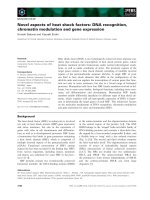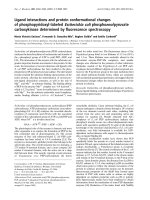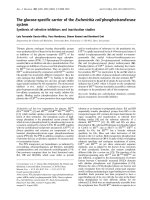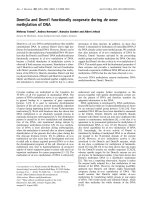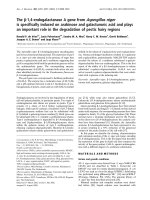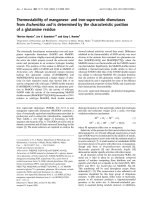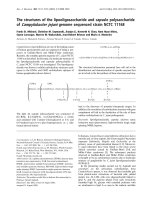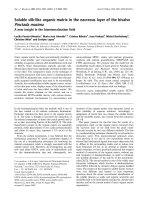Tài liệu Báo cáo Y học: Novel bradykinins and their precursor cDNAs from European yellow-bellied toad (Bombina variegata) skin potx
Bạn đang xem bản rút gọn của tài liệu. Xem và tải ngay bản đầy đủ của tài liệu tại đây (599.49 KB, 8 trang )
Novel bradykinins and their precursor cDNAs from European
yellow-bellied toad (
Bombina variegata
) skin
Tianbao Chen
1,2
, David F. Orr
1
, Anthony J. Bjourson
1
, Stephen McClean
1
, Martin O’Rourke
1
, David G. Hirst
1
,
Pingfan Rao
2
and Chris Shaw
1
1
School of Biomedical Sciences, University of Ulster, Coleraine, Northern Ireland, UK;
2
The Institute of Biotechnology,
Fuzhou University, Fujian Province, People’s Republic of China
Two novel bradykinin-related peptides (Ala3,Thr6)-bra-
dykinin and (Val1,Thr3,Thr6)-bradykinin, were identified
by a systematic sequencing study of peptides in the defensive
skin secretion of the yellow-bellied toad, Bombina variegata.
These peptides are the first amphibian skin bradykinins to
exhibit amino acid substitutions at the Pro3 position of the
bradykinin nonapeptide. Previously reported bradykinins
from other Bombina species were not detected. Respective
precursor cDNAs, designated BVK-1 and BVK-2, respect-
ively, were cloned from a skin library by 3¢-and5¢-RACE
reactions. BVK-1 contained an open-reading frame of 97
amino acids encoding a single copy of (Ala3,Thr6)-brady-
kinin and similarly, the open-reading frame of BVK-2 con-
sisted of 96 amino acids encoding a single copy of
(Val1,Thr3,Thr6)-bradykinin. Synthetic replicates of each
novel bradykinin were found to be active on mammalian
arterial and small intestinal smooth muscle preparations.
The structural diversity of bradykinins in amphibian
defensive skin secretions may be related to defence against
specific predators.
Keywords: amphibian; bradykinin; skin; precursor; cloning.
The skins of anuran amphibians, in addition to mucous
glands, contain highly specialized poison glands, which, in
reaction to stress or attack, exude a complex noxious
cocktail of biologically active molecules [1]. These secretions
often contain a plethora of peptides among which brady-
kinin or structural variants have been identified [2–5].
The kallikrein-kininogen system appears to be a common
target for certain venom components of many invertebrates
and vertebrates. Among snakes, venoms from members of
the Crotalinae (pit vipers) contain low molecular mass
peptides that inhibit angiotensin-converting enzyme – a
major bradykinin inactivating protease – thus potentiating
the activity of endogenous bradykinin [6]. These bradyki-
nin-potentiating peptides were the leads in developing
angiotensin-converting enzyme inhibitor drugs that are
frontline pharmaceuticals in the treatment of hypertension.
Peptides with angiotensin-converting enzyme inhibitory
activity have also been isolated from scorpion venom [7,8].
Wasp venoms contain bradykinin-related peptides that are
responsible for the reddening, oedema and intense pain
associated with envenomation by these insects [9,10]. These
molecular strategies appear to be related to either potenti-
ation of the effects of endogenous bradykinin by inhibition
of catabolic proteases (snakes and scorpions) or by local
delivery of supraphysiological quantities of bradykinins
(wasps and amphibians).
Although canonical bradykinin (RPPGFSPFR) has been
isolated fromthe European common frog (Rana temporaria),
with a range of minor N- and C-terminally extended forms
[11,12], other species of ranid frog have been found to
contain structural variants. These include (Thr6)-bradykinin
and (Thr6)-bradykinyl-IAPEIV in R. rugosa and (Val1,
Thr6)-bradykinin and (Val1,Thr6)-bradykinyl-VAPAS in
R. nigromaculata [13,14]. Additional structural variants
such as phyllokinin (bradykinyl-IYsulfated) have been
found in the skins of several South and Central American
leaf frogs (Phyllomedusa sp.) and bombinakinin O (brady-
kinyl-GKFH) in Bombina orientalis [15,16].
Attempts to generate and subsequently isolate/character-
ize endogenous bradykinins in the anuran amphibian
circulation, by activation of the kallikrein-kininogen system,
have met with no success. The use of standard activation
procedures in a range of species generated no detectable
bradykinin activity [17,18]. The apparent absence of a
circulatory kininogen in this group of tetrapods poses a
fundamental question as to the nature of the protein(s)
responsible for the generation of bradykinins in anuran skin.
In our laboratory, we have identified bradykinin and
(Thr6)-bradykinin in the skin secretion of B. orientalis and
a novel N-terminally extended bradykinin, maximakinin
(DLPKINRKGP-bradykinin), in the skin secretion of
Bombina maxima (
SWISSPROT
accession nos P83060,
Correspondence to C. Shaw, School of Biomedical Sciences,
University of Ulster, Cromore Road,
Coleraine BT52 1SA, Northern Ireland.
Tel.: + 44 2870 324611, Fax: + 44 2870 324965,
E-mail:
Abbreviations: Fmoc, 9 fluorenylmethoxycarbonyl; LC, liquid chro-
matography; MS, mass spectrometry; UPM, universal primer
mix; EC
50
, concentration required to elicit 50% release of
the maximum effect.
Note: The nucleotide sequences of Bombina variegata skin kininogens 1
and 2 have been deposited in the EMBL Nucleotide Sequence
Database under the accession codes AJ320269 and AJ318509,
respectively. The sequences of the novel isolated bradykinin-related
peptides can be accessed in
SWISSPROT
under accession numbers
P83056 and P83057, respectively.
Note: a website is available at
(Received 20 May 2002, revised 2 August 2002,
accepted 9 August 2002)
Eur. J. Biochem. 269, 4693–4700 (2002) Ó FEBS 2002 doi:10.1046/j.1432-1033.2002.03174.x
P83059, P83055, respectively), the latter was recently
described by another group using the name bombina-
kinin M [19]. We found that none of these bradykinins were
present in our archived LC/MS files of Bombina variegata
skin secretion. Although both B. orientalis and B. maxima
are from eastern Asia, we deemed it highly unlikely that their
European congenerics were devoid of members of this
peptide family. Here we describe the methodology employed
in addressing this question which has led to the discovery of
two novel, bradykinin-related peptides in the defensive skin
secretion of the yellow-bellied toad (B. variegata)andthe
subsequent cloning of their precursor cDNAs from a skin-
derived cDNA library. In addition, both peptides were
chemically synthesized and tested for bioactivity using two
different mammalian smooth muscle preparations.
MATERIALS AND METHODS
Identification and structural analysis
of novel bradykinins
Specimens of B. variegata (n ¼ 12) were obtained from a
commercial source as captive-bred metamorphs and were
raised to maturity in our vivarium for a period of
18 months. Skin secretions were obtained by mild trans-
dermal electrical stimulation [20]. Secretions were washed
from toads with distilled-deionized water, snap frozen in
liquid nitrogen and lyophilized. 5 mg quantities of freeze-
dried secretion were reconstituted in 0.5 mL of trifluoro-
acetic acid/water (0.1 : 99.9, v/v), clarified by centrifugation
and subjected to LC/MS using an LCQ
TM
electrospray ion-
trap mass spectrometer interfaced with a gradient HPLC
system (both supplied by ThermoFinnegan, San Jose, CA,
USA). The gradient employed was formed from (trifluoro-
acetic acid)/water (0.1 : 99.9, v/v) to trifluoroacetic acid/
water/acetonitrile (0.1 : 19.9 : 80.0, v/v/v) in 240 min at a
flow rate of 1 mLÆmin
)1
. The effluent from the chromato-
graphic column was flow split with 10% of flow entering the
mass spectrometer and 90% routed to a fraction collector.
Fractions (900 lL) were collected automatically at minute
intervals. Doubly charged ions were identified by isotopic
resolution and subjected to MS/MS fragmentation.
Sequence tags generated from fragment ions were database
trawled on-line. Peptides displaying C-terminal fragment
ion structural features of bradykinin (-PFR- y3-m/z 419,
y2-m/z 322, y1-m/z 175) were further subjected to structural
analysis by automated Edman degradation using an
Applied Biosystems 491 Procise sequencer. Fifty microliters
of the 900 lL fractions containing the putative bradykinin-
relatedpeptideswereusedineachcase.Thenovel
bradykinins identified were subsequently synthesized by
solid-phase Fmoc chemistry using an Applied Biosystems
433 peptide synthesiser. Products were purified and struc-
tures confirmed by LC/MS/MS. For pharmacological
experiments, standardization of each synthetic peptide was
achieved by acid hydrolysis of a known gravimetric quantity
of lyophilisate followed by amino acid analysis using an
Applied Biosystems PTH-amino acid analyser.
cDNA cloning
Dorsal skin was excised from two dead adult toads, frozen
in liquid nitrogen and polyadenylated mRNA was isolated
using magnetic oligo-dT beads as described by the manu-
facturer (Dynal Biotec, UK) and reverse transcribed. The
cDNA was subjected to a 5¢-and3¢- RACE procedure to
obtain full-length preprobradykinin nucleic acid sequence
data using a SMART-RACE kit essentially as described by
the manufacturer (Clontech, UK). Briefly, the 3¢-RACE
reactions employed a UPM primer (supplied with the kit)
and a sense primer (Brady-S1; 5¢-AARGGICCIMG
ICCICCIGGITTY-3¢) that was complementary to the
amino acid sequence -KGPRPPGF- of maximakinin
(
SWISSPROT
accession no. P83055). The PCR products were
gel-purified and cloned using a pGEM-T vector system
(Promega Corporation) and sequenced using an ABI 3100
automated capillary DNA sequencer. The sequence data
obtained from these 3¢-RACE products were used to design
a specific antisense primer for the 5¢-RACE reaction,
BVAS-1 (5¢-ATATCAGGGGACGCTACTTC-3¢). Subse-
quent products were gel-purified, cloned and sequenced as
described above. Following acquisition of these data,
specific sense primers were designed to the N-terminal
coding region of each respective peptide (Ala3,Thr6 BK-5¢-
ATCAGCCGCCTACAAAGACGTCCAGCG-3¢,Val1,
Thr3,Thr6-BK-5¢-TCAGCCGCCTACAAAGAGTTCCA
AC-3¢) and employed in 3¢-RACE reactions. Products were
gel-purified, cloned and sequenced.
Smooth muscle pharmacology
Male albino Wistar rats (200–350 g) were killed by
asphyxiation followed by cervical dislocation. The tail
artery was prepared as previously described [21]. Incubation
buffer was 95% O
2
/5% CO
2
oxygenated Krebs’ solution
(NaCl 118 m
M
,KCl4.7m
M
,NaHCO
3
25 m
M
,NaH
2
PO
4
1.15 m
M
,CaCl
2
2.5 m
M
,MgCl
2
1.1 m
M
,glucose5.6m
M
).
Constriction or dilation of the arterial smooth muscle
preparation was detected by an increase or decrease in
pressure generated by water column displacement using
pressure transducers connected to a MacLab System
(AD Instruments Pty Ltd. Australia). Data were dis-
played graphically on a Macintosh computer. Viability
was determined using a range of bolus phenylephrine
(5 · 10
)6
M
–1 · 10
)3
M
) exposures and the endothelial
layer of the artery was removed by bubbling with oxygen
for 10 s. Absence of the endothelial layer was confirmed by
the lack of relaxation in response to a 30-min perfusion of
acetylcholine (5 · 10
)5
M
) after preconstriction with phenyl-
ephrine (1 · 10
)5
M
). After perfusion of arterial prepar-
ations with 1 · 10
)5
M
phenylephrine to obtain constriction
plateaux, relative relaxation was recorded following appli-
cations of bradykinins in the range of 1 · 10
)10
to
1 · 10
)5
M
. Peptides were added consecutively in increasing
concentrations, each addition being followed by a wash out
and equilibration phase.
For intestinal smooth muscle preparations, 1-cm seg-
ments of ileum were carefully placed onto the pins of a
MacLab force transducer, one pin acting as a stationary
fixed point while the second pin was free, permitting
application of tension to the smooth muscle. The muscle
segments were gradually exposed to 0.1 g increments in
resting tension until the spontaneous contractions origin-
ated from a resting tension of 0.5 g. The contracting
muscle preparations were allowed to stabilize for 25 min
before the application of bradykinins. The intestinal
4694 T. Chen et al. (Eur. J. Biochem. 269) Ó FEBS 2002
smooth muscle preparations were exposed to peptides as
described previously and relative changes in tension were
recorded.
RESULTS
Identification and structural analysis
of novel bradykinins
Analysis of stimulated skin secretions by LC/MS/MS, with
subsequent sequence calling based upon fragment ions,
revealed the presence of two, novel bradykinin-related
peptides (Fig. 1). As the more readily fragmented doubly
charged ions from each peptide were used for MS/MS
fragmentation, the resultant spectra contained both singly
and doubly charged fragment ions. The theoretical and
observed fragment ions from each peptide are shown
in Table 1. The primary structures, RPAGFTPFR
(Ala3,Thr6-bradykinin) (theoretical mass 1049.23 Da,
observed mass 1049.31 Da) and VPTGFTPFR (Val1,
Thr3,Thr6-bradykinin) (theoretical mass 1022.20 Da,
observed mass 1022.5 Da), were confirmed by automated
Edman degradation of respective peptides identified from
RP-HPLC fractions (Fig. 2). Bradykinin (1060.22 Da)
and bombinakinin O (1529.76 Da) were not detected in
B. variegata skin secretion despite exhaustive interrogation
of LC/MS archived data with deduced singly and doubly
charged ion molecular masses of each peptide. The struc-
tures of amphibian skin bradykinin-related peptides are
compared with those described in the present study in
Table 2.
cDNA cloning
Two different preprobradykinin cDNAs were consistently
cloned from the skin library and each encoded a single copy
of a novel bradykinin-related peptide (Ala3,Thr6)-brady-
kinin (BVK-1) or (Val1,Thr3,Thr6)-bradykinin (BVK-2)
(Figs 3 and 4, respectively). Open-reading frames consisted
of 97 and 96 amino acid residues, respectively. Alignments
of both open-reading frame DNA (Fig. 5) and amino acid
sequences (Fig. 6), using the
ALIGNX
programme of the
VECTOR NTI
bioinformatics suite (Informax), revealed that
bradykinin-related peptide encoding regions, were located
at identical positions within the precursors. Both prepro-
bradykinins exhibited a high degree of both nucleotide and
primary structural similarity with heterogeneity predomi-
nantly localized to the C-terminal regions. Mature peptides
were flanked both N- and C-terminally by identical
propeptide convertase processing sites probably involving
a protease with Arg-X cleavage specificity. Both bradykinin-
related peptides were flanked at the C-terminus by the
tetrapeptide sequence, -GKFH-, a motif previously identi-
fied as the extension to bradykinin found in bombinaki-
nin O from B. orientalis, a related species from Korea and
Northern China [16].
Smooth muscle pharmacology
Synthetic replicates of the novel bradykinin-related peptides
produced dose-dependent relaxation of rat arterial smooth
muscle and constriction of intestinal smooth muscle, though
molar potencies were found to be different when compared
to bradykinin (Figs 7 and 8). In arterial smooth muscle
(Ala3,Thr6)-bradykinin was approximately 10 times more
potent by ED
50
but produced a lower maximal response
than bradykinin (Fig. 7). In contrast (Val1,Thr3,Thr6)-
bradykinin was approximately 100 times less potent than
bradykinin in inducing arterial smooth muscle relaxation
(Fig. 8). Both novel bradykinin-related peptides were less
potent (by approximately two orders of magnitude) than
bradykinin in constricting small intestinal smooth muscle.
DISCUSSION
(Ala3,Thr6)-bradykinin and (Val1,Thr3,Thr6)-bradykinin
represent two novel bradykinin-related peptides isolated
from the defensive skin secretion of the European yellow-
bellied toad, B. variegata. Their presence in skin and their
primary structures were confirmed by cloning of two
different but very similar precursor cDNAs each encoding
a single copy of the respective peptides.
The technique of LC/MS employed here is an extremely
versatile technology when applied to amphibian skin
peptide research. The archiving of complete molecular mass
data for a defensive skin secretion from a given species,
renders it possible to interrogate such data sets in a number
of ways using manufacturer’s software. Computed mole-
cular masses of charged parent ion series can be used to
determine the presence of known peptides from other
species in a very rapid manner. The finding of coincident
and identically charged parent ion series is highly indicative
of structural identity. Subsequent MS/MS fragmentation
and comparison of generated fragment ion profiles with
those predicted from the query sequence can establish
Fig. 1. MS/MS spectra of novel B. varieg ata skin bradykinin-related
peptides. (A) (Ala3,Thr6)-bradykinin and (B) (Val1,Thr3,Thr6)-bra-
dykinin.
Ó FEBS 2002 Novel bradykinins of B. variegata skin (Eur. J. Biochem. 269) 4695
identity beyond doubt. Likewise, failure to identify charged
parent ion series is highly indicative of the absence of the
query sequence. In this study, we have successfully used
fragment ion identity from a conserved primary structural
domain at the C-terminus of bradykinin (Ôsequence tagsÕ)as
a tool for locating putative related peptides, in the absence
of known variants in the skin secretion.
In a recent review of bradykinins in nonmammalian
vertebrates, it was stated that bradykinin was undetectable
in the skins of several species of European amphibians of the
closely related genera, Bombina, Alytes and Discoglossus
[22]. While it may be true that canonical bradykinin is not
present, the data presented here unequivocally demonstrate
the presence of two, novel bradykinin-related peptides in a
European bombinid toad. In addition, these data may
provide an insight into the apparent absence of a circulating
kallikrein-kinin system in anuran amphibians [17,18,23].
The high degree of primary structural variability of
bradykinins in amphibian skin secretions, their differing
spectra of bioactivity and the lack of information on
bradykinin receptor subtypes and pharmacology in
amphibians, may mean that, in the past, inappropriate
bio- and/or immuno-assays have been employed to detect
the endogenous circulatory kinins.
However, it is most probable that anuran amphibians
expressing bradykinins in skin granular glands employ these
for a quite different biological purpose. Each cloned
amphibian skin preprobradykinin displays little structural
similarity with cloned mammalian prekininogens [24] apart
from the actual kinin coding sequence. Circulating kinino-
gens represent a large pool of inactive peptide precursor and
relatively small quantities are cleaved, often locally in
tissues, to generate active kinin [25]. In contrast, amphibian
skin preprobradykinins exhibit molecular dynamics gener-
ally associated with peptide hormone precursors in that the
intact high molecular mass precursor is not detectable in
secretions but rather the fully processed active peptides.
Indeed, the amphibian’s active kinin products are destined
for export as products of a defensive skin secretion rather
than for action as a local hormone within endogenous
tissues. For all of these reasons, it is most probable that
mammalian kininogens and amphibian skin probradykinins
are not in the biological sense, homologous proteins.
Analysis of the cloned precursor primary structures,
however, indicates generation of the bradykinins by
Table 1. Predicted MS/MS singly and doubly charged fragment ions of (Ala3,Thr6)-bradykinin and (Val1,Thr3,Thr6)-bradykinin. Observed ions are
in bold typeface.
Residue b y (+1) Sequence # b y (+2)
(Ala3,Thr6)-bradykinin
R1 157.1 1048.6 9 R 1 79.1 524.8 9
P2 254.2 892.4 8 P 2 127.6 446.7 8
A3 325.2 795.4 7 A 3 163.1 398.2 7
G4 382.2 724.4 6G 4191.6 362.7 6
F5 529.3 667.3 5 F 5 265.1 334.2 5
T6 630.3 520.3 4 T 6 315.7 260.6 4
P7 727.4 419.2 3P 7364.2 210.1 3
F8 874.4 322.2 2 F 8 437.7 161.6 2
R9 1030.6 175.1 1R 9515.8 88.1 1
(Val1,Thr3,Thr6)-bradykinin
V1 100.1 1021.5 9 V 1 50.5 511.3 9
P2 197.1 922.5 8 P 2 99.1 461.7 8
T3 298.2 825.4 7 T 3 149.6 413.2 7
G4 355.2 724.4 6 G 4 178.1 362.7 6
F5 502.3 667.3 5 F 5 251.6 334.2 5
T6 603.3 520.3 4 T 6 302.2 260.6 4
P7 700.4 419.2 3 P 7 350.7 210.1 3
F8 847.4 322.2 2 F 8 424.2 161.6 2
R9 1003.5 175.1 1R 9502.3 88.1 1
Fig. 2. RP-HPLC chromatogram (y axis ¼ relative abundance at
k214nm in normalized arbitrary absorbance units) of B. variegata skin
secretion. Retention times of novel bradykinin-related peptides are
indicated below respective automated Edman degradation data.
4696 T. Chen et al. (Eur. J. Biochem. 269) Ó FEBS 2002
proteolysis involving Arg-X cleavages (except apparently
where X ¼ Pro) consistent with the known cleavage site
specificity of a kallikrein-type endoproteinase [26] but also
with known vertebrate prohormone convertases [27]. The
occurrence of additional molecular variants of bradykinins,
especially phyllokinin (bradykinyl-IYsulfate) and C-termin-
ally extended forms in Rana frogs [12–15], would imply that
the preprobradykinin organization, described here for
B. variegata, either differs from that present in other anuran
amphibians or that cleavage specificities of skin peptide
precursor convertases are different. Only one amphibian
skin bradykinin-related peptide precursor cDNA has been
cloned to date [19]. Bombinakinin M (syn. maximakinin) is
a N-terminal decapeptide-extended bradykinin from the
skin secretion of the Chinese large-webbed bell toad,
Bombina maxima. This precursor cDNA encodes six
tandem repeat copies of the mature nonadecapeptide and
interestingly, the convertase cleavage sites, both N- and
C-terminally, are Arg-X, in common with those observed
for the novel bradykinins in the present study. However,
while the C-terminal cleavage site is identical to that
observed in both precursors cloned in the present study, the
N-terminal arginyl residue cleavage site has been substituted
with a prolyl residue. The propeptide convertases in this
species, appear to disregard the -Arg-Lys- doublet two
positions proximal to this substitution and rather cleave at
the C-terminal side of the single arginyl residue, seven
positions proximal to this site (Table 2). This results in
incorporation of the decapeptide extension on the brady-
kinin nonapeptide with an N-terminal aspartyl residue
(Table 2). Strategically located single site amino acid substi-
tutions can thus drastically affect the primary structure of
Table 2. Amino acid sequence alignments of amphibian skin bradykinins. Substituted and extension residues in bold. Fully conserved residues
indicated by asterisks.
*****
RP
AGFTPFR Bombina variegata
V
PTGFTPFR Bombina variegata
RPPGFSPFR Rana temporaria [11], R. palustris [28], Bombina orientalis
RPPGFTPFR Rana rugosa [13], Bombina orientalis
VPPGFTPFR Rana nigromaculata [14]
RPPGFSPFR
GKFH Bombina orientalis [16]
DLPKINRKGPRPPGFSPFR Bombina maxima [19]
RPPGFSPFR
IY(SO
3
H) Phyllomedusa sp. [15]
RPPGFSPFR
IA Rana temporaria [12]
RPPGFSPFR
IAPASTL Rana temporaria [12]
RPPGFSPFR
IAPASIL Rana temporaria [12]
RPPGFSPFR
VAPAS Rana nigromaculata [14]
IRRPPGFSPLR Rana palustris [28]
IRRPPGFSPLRIA Rana palustris [28]
AGIRRPPGFSPLR Rana palustris [28]
AGIRRPPGFSPLRIA Rana palustris [28]
Fig. 3. Nucleotide sequence of B. variegata skin preprobradykinin-1
(BVK-1) cDNA encoding a single copy of (Ala3,Thr6)-bradykinin
(double underlined). The putative signal peptide (single underlined) and
stop codon (asterisk) of the open-reading frame are indicated.
Fig. 4. Nucleotide sequence of B. variegata skin preprobradykinin-2
(BVK-2) cDNA encoding a single copy of (Val1,Thr3,Thr6)-bradykinin
(double underlined). The putative signal peptide (single underlined) and
stop codon (asterisk) of the open-reading frame are indicated.
Ó FEBS 2002 Novel bradykinins of B. variegata skin (Eur. J. Biochem. 269) 4697
the mature peptide by altering propeptide convertase
cleavage sites in the precursor as discussed. Each cloned
precursor described in the present study, in contrast,
generates a mature nonapeptide with internal amino acid
substitutions that do not affect the appropriate propeptide
convertase processing patterns. Additionally, although
B. maxima is a congeneric of B. variegata, the latter species
possesses skin bradykinin precursors that encode but single
copies of mature peptides.
As previously stated, neither bombinakinin O (bradyki-
nyl-GKFH) [16], a peptide isolated from B. orientalis skin
extracts, nor canonical bradykinin, were detected in
stimulated skin secretion from B. variegata. However,
examination of cloned skin cDNA open-reading frames
encoding both novel bradykinin-related peptides described
here, indicates that in both cases, the coding sequences of
mature peptides are flanked C-terminally in their respect-
ive precursors by the tetrapeptide sequence, -GKFH. The
possibility was thus presented that cleavage at and
removal of the lysyl residue in this sequence could expose
a terminal glycyl residue that could function as an amide
donor. That is, a possibility existed that both bradykinin-
related peptides described here, could be C-terminally
amidated. To exclude this possibility, each natural peptide
was subjected to MS/MS fragmentation either alone or
mixed with its appropriate synthetic C-terminal free acid
replicate. The natural and synthetic peptides produced
identical b and y fragment ion series indicating unequi-
vocally that the natural forms were not C-terminally
amidated. Carboxy-terminal amidation would have pro-
duced a y fragment ion series exhibiting a 1 Da decrement
in m/z ratios. This sensitivity is well within the capability
of the ES-MS system employed.
The primary structural diversity displayed within
amphibian skin bradykinins may not simply be due to
phylogenetic differences but may reflect a degree of
specific predator-mediated natural selection. Other major
bioactive peptides found in amphibian skin secretions,
including bombesins, tachykinins and caeruleins, have
active sites that are highly conserved among vertebrate
taxa and hence these would activate homologous receptors
in a wide spectrum of predatory species [1]. Until quite
recently, the primary structures of endogenous bradyki-
nins in nonmammalian vertebrates were unknown. Acti-
vation of the circulatory kallikrein-kinin system in a small
but representative sample of species and isolation of the
generated kinin has established that canonical bradykinin
Fig. 5. Alignment of the nucleotide sequences of full-length clones of
BVK-1 and BVK-2. Identical bases are shaded. The
ALIGNX
program
of
VECTOR NTI
suite (Informax) was employed.
Fig. 6. Alignment of open-reading frame amino acid sequences of BVK-1
and BVK-2. Identical amino acid residues are shaded.
ALIGNX
pro-
gramme of
VECTOR NTI
suite (Informax) employed.
Fig. 7. Dose–response curves of bradykinin and (Ala3,Thr6)-bradykinin
on rat arterial smooth muscle (A) and small intestinal smooth muscle (B)
preparations. Each data point represents the mean ± SEM of six
replicates.
4698 T. Chen et al. (Eur. J. Biochem. 269) Ó FEBS 2002
is probably restricted to mammals [22]. Structure–activity
studies using bradykinin analogues and alanine scan series,
in a range of preparations of mammalian smooth muscle
types, have indicated an almost absolute requirement for
Arg1, Pro2, Gly4, Phe5, Pro7, Phe8 and Arg9 [25].
Interestingly, most of these residues are fully conserved in
amphibian skin bradykinins with the exception of the
(Leu8)-bradykinins from R. palustris [28], that in common
with avian bradykinin, share this site substitution [22]
(Table 2). However, these structure–activity data would
explain the relatively low activity of (Val1,Thr3,Thr6)-
bradykinin in both of the smooth muscle preparations
employed in this study, in contrast to the activity observed
for the Ala3,Thr6-substituted variant (Figs 7 and 8).
Crocodilians, chelonians and varanid lizards possess
(Thr6)-bradykinin whilst colubrid and crotalid snakes
possess (Val1,Thr6)-bradykinin [22]. Indeed, a threonyl
residue at position 6 appears to be present in virtually all
bradykinins from nonmammalian, tetrapod vertebrates
studied to date [22].
The freshwater habitats of amphibians possessing brady-
kinins in their defensive skin secretions would be rich in an
array of predatory species predominantly from these taxa.
We contend, on this basis, that the spectrum of bradykinins
possessed by each species is reflective and perhaps, by
natural selection of peptide libraries generated in dermal
venom glands, dictated by predominant predators cohabi-
ting the amphibian biotopes. B. variegata, from Europe, on
this basis, would possess specific defence against chelonian
and colubrid snake predators, both of which occur in the
same habitats as the toad.
The focused study of bioactive peptides produced by the
amphibian integument can thus provide much valuable
information into structure–activity relationships and nat-
ural molecular evolutionary strategies that can be relevant
to a broad range of disciplines within the biosciences.
ACKNOWLEDGEMENTS
Chen Tianbao is in receipt of a Vice Chancellor’s Research Studentship
at the University of Ulster and we thank the Fujian Government,
People’s Republic of China for financial support and other assistance.
REFERENCES
1. Lazarus, L.H. & Atilla, M. (1993) The toad, ugly and venomous,
wears yet a precious jewel in his skin. Prog. Neurobiol. 41, 473–507.
2. Erspamer, V., Falconieri-Erspamer, G., Mazzanti, G. & Endean,
R. (1984) Active peptides in the skins of one hundred amphibian
species from Australia and Papua New Guinea. Comp. Biochem.
Physiol. 77C, 99–108.
3. Erspamer, V., Falconieri-Erspamer, G. & Cei, J.M. (1986) Active
peptides in the skins of two hundred and thirty American
amphibian species. Comp. Biochem. Physiol. 85C, 125–137.
4. Roseghini, R., Falconieri-Erspamer, G. & Severini, C. (1988)
Biogenic amines and active peptides in the skin of fifty-two
African amphibian species other than bufonids. Comp. Biochem.
Physiol. 91C, 281–286.
5. Roseghini,R.,Falconieri-Erspamer,G.,Severini,C.&Simmaco,
M. (1989) Biogenic amines and active peptides in extracts of the
skin of thirty-two European amphibian species. Comp. Biochem.
Physiol. 94C, 455–460.
6. Higuchi, S., Murayama, N., Saguchi, K., Ohi, H., Fujita, Y.,
Camargo, A.C.M., Ogawa, T., Deshimaru, M. & Ohno, M. (1999)
Bradykinin-potentiating peptides and C-type natriuretic peptides
from snake venom. Immunopharmacology 44, 129–135.
7. Ferreira, L.A.F., Alves, E.W. & Henriques, O.B. (1993) Peptide-T,
a novel bradykinin potentiator isolated from Tityus serrulatus
scorpion venom. Toxicon 31, 941–947.
8. Meki, A.R.M.A., Nassar, A.Y. & Rochat, H. (1995) A bradyki-
nin-potentiating peptide (peptide K12) isolated from the venom of
Egyptian scorpion, Buthus Occitanus. Peptides 16, 1359–1365.
9. Pisano, J.J. (1966) Wasp kinin. Mem. Inst Butantan Simp. Inter-
nac. 33, 441–446.
10. Yoshida, H., Geller, R.G. & Pisano, J.J. (1976) Vespulakinins:
new carbohydrate-containing bradykinin derivatives. Biochem-
istry 15, 61–64.
11. Anastasi, A., Erspamer, V. & Bertaccini, G. (1965) Occurrence of
bradykinin in the skin of Rana temporaria. Comp.Biochem.Phy-
siol. 14, 43–52.
12. Conlon, J.M. & Aronsson, U. (1997) Multiple bradykinin-related
peptides in the skin of the frog, Rana temporaria. Peptides 18, 361–
365.
13. Yasuhara, T., Ishikawa, O., Nakajima, T., Araki, K. & Tachi-
bana, S. (1979) The studies on the active peptide on smooth muscle
in the skin of Rana rugosa,Thr
6
-bradykinin and its analogue
peptide, ranakinin R. Chem. Pharm. Bull. (Tokyo) 27, 486–491.
14. Nakajima, T. (1968) Occurrence of new active peptides on smooth
muscle and bradykinin in the skin of Rana nigromaculata Hallo-
well. Chem. Pharm. Bull. (Tokyo) 16, 769–774.
15. Anastasi, A., Bertaccini, G. & Erspamer, V. (1966) Pharmacolo-
gical data on phyllokinin (braykinyl-isoleucyl-tyrosine-0-sulphate)
and bradykinyl-isoleucyl-tyrosine. Br.J.Pharmacol.27, 479–485.
16. Yasuhara, T., Hira, M., Nakajima, T., Yanaihara, N. &
Yanaihara, C. (1973) Active peptides on smooth muscle in the
Fig. 8. Dose–response curves of bradykinin and (Val1,Thr3,Thr6)-bra-
dykinin on rat arterial smooth muscle (A) and small intestinal smooth
muscle (B) preparations. Each data point represents the mean ± SEM
of six replicates.
Ó FEBS 2002 Novel bradykinins of B. variegata skin (Eur. J. Biochem. 269) 4699
skin of Bombina orientalis Boulenger and characterization of a
new bradykinin analog. Chem. Pharm. Bull. (Tokyo) 21, 1388–
1139.
17. Rabito, S.F., Biia, A. & Segovia, R. (1972) Plasma kininogen
content of toads. Comp. Biochem. Physiol. 41A, 281–284.
18. Seki, T., Miwa, I., Nakajima, T. & Erdos, E.G. (1973) Kallikrein-
kinin system in non-mammalian blood. Am.J.Physiol.224, 1425–
1430.
19. Lai, R., Liu, H., Hui Lee, W. & Zhang, Y. (2001) A novel bra-
dykinin-related peptide from skin secretions of toad Bombina
maxima and its precursor containing six identical copies of the
final product. Biochem. Biophys. Res. Commun. 286, 259–263.
20. Tyler, M.J., Stone, D.J.M. & Bowie, J.H. (1992) A novel method
for the release and collection of dermal, glandular secretions from
the skin of frogs. J. Pharmacol. Toxicol. Meth. 28, 199–200.
21. Hirst, D.G., Kennovin, G.D. & Flitney, F.W. (1994) The radio-
sensitizer nicotinamide inhibits arterial vasoconstriction. Br. J.
Radiol. 67, 795–799.
22. Conlon, J.M. (1999) Bradykinin and its receptors in non-mam-
malian vertebrates. Regul. Pept. 79, 71–81.
23. Dunn, R.S. & Perks, A.M. (1975) Comparative studies of plasma
kinins: the kallikrein-kinin system in poikilotherm and other
invertebrates. General Comp. Endocrinol. 26, 165–178.
24. Takano, M., Kondo, J., Yayama, K., Otani, M., Sano, K. &
Okamoto, H. (1997) Molecular cloning of cDNAs for mouse
low-molecular weight and high-molecular weight prekininogens.
Biochim. Biophys. Acta. 1352, 222–230.
25. Regoli, D. & Barabe, J. (1980) Pharmacology of bradykinin and
related kinins. Pharmacol. Rev. 32, 1–46.
26. Bhoola, K.D., Figueroa, C.D. & Worthy, K. (1992) Bioregulation
of kinins: Kallikreins, kininogens and kinases. Pharmacol. Rev. 44,
1–80.
27. Seidah, N.G., Day, R. & Chretien, M. (1993) The family of pro-
hormone and pro-protein convertases. Biochem. Soc. Trans. 21,
685–691.
28. Basir, Y.J., Knoop, F.C., Dulka, J. & Conlon, J.M. (2000) Mul-
tiple antimicrobial peptides and peptides related to bradykinin and
neuromedin N isolated from skin secretions of the pickerel frog,
Rana palustris. Biochim. Biophys. Acta. Protein Structure Mol.
Enzymol. 1543, 95–105.
4700 T. Chen et al. (Eur. J. Biochem. 269) Ó FEBS 2002
